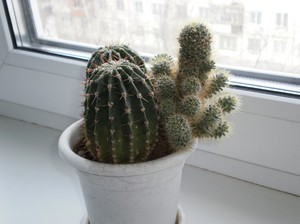
Cacti: budding and flowering. Flowering cacti at home: how to make it bloom?
In the last 3-4 decades, cactus plants have literally poured into the apartments of domestic nature lovers, often crowding out all other green abodes of our cramped window sills. And after the well-known changes in the economy and politics of the countries of the former USSR, only the lazy have never held any in their hands. In many cities there are clubs of cacti lovers, whose collections convincingly illustrate how to please your eye with the magnificence of flowering with a minimum of occupied space. Undoubtedly, the flowers of most cacti are delightfully beautiful and delicate, very diverse in color (all colors and shades except blue), surprisingly contrasting with the harsh thorns and thorns surrounding them. Some of them are several times larger than the size of the plant itself, others have a pleasant aroma, the fruits of the third are of gastronomic interest, resembling raspberries, strawberries, etc., and certain types trying to accommodate all of the above charms.
In the light of the foregoing, the enthusiasm with which collectors talk about the flowering of their prickly wards is quite understandable ...
Nowadays, even a beginner is well aware that the plants of the CACTACEAE family, for the most part, bloom willingly and profusely throughout their conscious life. If, when choosing an assortment, you are not limited to any one taxon or region, and even add epiphytic species, then you can make a collection of cacti that bloom continuously throughout the year (continuity here means the presence of at least one flower every day).
However, it would be naive to believe that all problems end with a competent selection of species. In order to be touched by a new bud every day, you need to help your pets open up a little in all their splendor by fulfilling a number of requirements for caring for them.
1. Selection of plants for the collection.
Theoretically, any cactus should bloom. And to bring each plant to flowering is a kind of duty of honor, the ultimate goal of the collector. In fact, with proper care, the seedlings of most rebutias, mediolobivia, ailoster, frails, individual mammillaria, small-seeded parodies throw out buds in the second or third year of life; some Echinocereus, many Mammillaria, cacti of the Echinopsis-Lobivia group (Lobivia, Echinopsis nets, Acanthocalyciums ...) - in the fourth or fifth year, etc.
For beginner cactus growers, we can recommend that you definitely include in your assortment Mammillaria with whole corollas of flowers on the crown, abundantly and brightly blooming in early spring, rebucias and a little later - aylosters, simple parodies and notocactus in culture with relatively large and catchy flowers, many types of Echinocereus with large, up to a week holding silky flowers, unpretentious hymnocalyciums, echinopsis-lobivia with huge (up to 17 cm long), but quickly fading flowers, gratefully and luxuriously blooming zygocacti, epiphyllums and many, many others that the amateur will get to know himself, gradually delving into the cactus kingdom .
In this paragraph, we will only try to warn against possible disappointments in some cases.
but) In almost every genus (both in parodies, and in mammillaria, and in hymnocalyciums ...) there are exceptions that bloom much later than their counterparts. Therefore, for starters, you should stop your attention on the most popular types.
b) Some of the genera in our collections descend to flowering at a very mature age or do not bloom at all, requiring greenhouse conditions for this. These include many pillar-shaped cereus: espostoy, haageocereus, stetson, etc. Even in the collections of the south of Russia and Ukraine, you can find not so many flowering specimens of eriocactus, ferocactus, yubelmannia, decorated astrophytum (ornatum), reaching sexual maturity in 12- 15 years. Without forming cephaly, melo- and discocactus will never give buds, and even grafting practically does not accelerate the formation of cephaly in melocactus ... Without a doubt, the genera and species listed in this subparagraph have high decorative qualities, but this, as they say, already another article.
c) Perhaps you should not immediately grab onto expensive exotic material. Difficult and rare plants(ariocarpus, pedio-, roseo-, sclero-, discocactus, Navajoa, peleciphora and some other Mexican species) will not always reward the beginner with buds, to whom these notes are oriented.
G) The purchased material must be of high quality. Sick, viral, with a poorly developed root system, specimens may die before they bloom; and, thus, unfairly discourage the desire to deal with cacti in general. Purchased imported plants with glued or stuck dried flowers are unpromising in terms of their own flowering for a number of reasons. Crested and monstrous forms are very capricious in terms of flowering.
e) Children of a high order, i.e. plants obtained by repeated vegetative propagation, in some cereus, simply lose their desire to bloom, each time throwing out another batch of children instead of buds.
e) When buying adult or imported plants, time is required for their acclimatization. Beginners need to be gradually accustomed to your lighting conditions, irrigation regime, and the composition of the earth mixture. In most situations, the acquisition of recruits should be immediately followed by their transplantation. In fairness, it should be noted that individual cacti, like any other living organisms, do not always successfully perceive new conditions of existence. This is especially true of savages - plants collected in the wild, i.e. in habitats.
g) The problem of acclimatization completely disappears if the collection is replenished at the expense of one's own seedlings. Sowing seeds is the most promising way to get healthy, well-formed and abundantly flowering cacti. True, this will require certain skills and abilities. This topic is discussed in sufficient detail in many cactus publications, so sow, do not be afraid! On this path, only one disappointment can await you - the discrepancy between the grown plants and the types of seeds sown. Therefore, try to use reliable, trusted sources - the honesty and accuracy of the seed seller will save you several years. Note also that it is not the intention here to warn against hybrid seeds in general. In many cases (during cross-pollination of species that are morphologically not very distant from each other), mestizos are more viable than their parents. In the catalogs of some foreign seed companies, abundant and very decorative flowering hybrid lobivia, echinocereus, echinopsis, epiphyllums are of particular interest ...
2. Competent agricultural technology
Flowering, despite the seeming commonness of this phenomenon, is a crucial moment in the life of a plant and it must be prepared for it. An exhausted plant is not able to please with abundant flowering. The halo of the martyr, erected around the cactus by the legend of his death after flowering, in this case is not far from the truth - the plant is simply unable to survive, giving its last breaths to a stunted flower ...
Let us briefly dwell on those cultivation methods on which flowering depends in one way or another.
but) It is necessary to provide maximum light. The distribution areas of cacti leave no doubt that the sun is in abundance there. Therefore, in our latitudes, it makes sense to squeeze out everything that is possible from the lighting conditions - there will not be much anyway. First of all, it is the southern or southeastern orientation of the windows, clean glass, window greenhouses, placing plants on the balcony, etc. If possible, take the collection to the dacha in the summer, and the more south the dacha, the better. But, if you do not have hacienda somewhere in the Kuban or Central Asia, do not despair - even at the latitude of Moscow, most types of sun will be enough for abundant flowering. Epiphytic cacti - the inhabitants of tropical rainforests - are much less demanding of direct sunlight. Sick, freshly transplanted specimens, seedlings of many species up to 1-2 years of age, plants after wintering and individual cacti placed on southwestern windows also need light shading ( sunstroke in the afternoon hours). A warning about the danger of a burn can be an atypical color of the epidermis for this species (yellowing, redness, etc.). It is also useful to know that some South American cacti (rebutia, notocactus, neochilenium, etc.) can simply fall into a kind of hibernation (stagnation) during the summer heat.
b) Warm. However, it should be clarified that the cause of summer stagnation is not so much an excess of sunlight as high air temperature. When temperatures rise to 40C, vegetation slows down or stops altogether in almost all cacti ... Each species has its own optimal temperature ranges. Of course, you can limit yourself to more or less universal recommendations such as: + 20 + 25C is good for Mexicans during the growing season at night, and + 15 + 20C for South Americans. But nature is much more diverse ...
With a lack of heat, the buds of some cacti (telocactus) will stop developing and dry out, others (pediocactus) will slow down their development until better times (for example, until spring); mammillaria can fully open its flowers, but not form fruits; astrophytum is too lazy to dissolve the flower so much that a pistil appears from there; frailea will not even think of opening a bud, but miraculously forms a fruit; and brasilicactus in January will keep its flowers open for a whole month, and then it will also give seeds. Discocactus blooms on a warm (over 20C) night, lobivia turns its petals only in the dazzling sun, but hymnocalycium does not need bright light, the main thing is high temperature at noon and afternoon hours, high humidity and carbon dioxide concentration. It is desirable for a cactus grower to know all these (and other) individual characteristics of their wards in order to properly help them reach the condition.
in) Proper nutrition. Cacti need to get plenty of nutrients in order to bloom for a long time and profusely. Fortunately, they are not very picky. It is enough to transplant seedlings (and adult plants even less often) into fresh soil once a year to make up for the lack of elements in the soil. As practice shows, sunlight (see above) and the acid-base reaction of the pH of the earth mixture are more important. With a little stretch, we can say that almost all species can develop and bloom in soil with pH = 5.5-6.0. More detailed information it is easy to find the composition of soil mixtures and the frequency of watering in the specialized literature (we also recommend looking at the tips. We only note that it is advisable to use soft (rain boiled, acidified ...) water for irrigation so as not to aggravate the pH in your pots over time. for the same reason, you should not use large dishes - the roots should master the entire earthen lump.In addition, in spacious pots, some cacti (for example, mammillaria) have a reduced urge to seed reproduction, i.e. to bloom.
During the period of active vegetation and sufficient insolation, do not shy away from fertilizers. Of course, liquid manure is of little use for this purpose (organics for cacti should be generally avoided), but many mineral complex fertilizers (diluted several times stronger than indicated in the instructions) will work a couple of times per season ... In the second half of summer and at the stage of budding nitrogen must be excluded from the fertilizer mixture. Potassium phosphate monosubstituted is best suited for feeding at this time. But still it is better to remember that in the homeland of most green hedgehogs, soils are poor in humus. Overfed and overwatered plants look cheerful only for a very short time - then they begin to loosen, deform, crack, get sick, and when you look at them, the last thing you want to think about is such a beautiful phenomenon as flowering.
The lion's share of the problems of cultivating cacti is removed by their grafting onto more hardy species of cereus, echinopsis, eriocereus, chylocereus, etc. Perhaps a beginner and not very skilled in grafting a cactus grower should acquire grafted plants, the culture of which is much simpler. Receiving intensive nutrition, the grafts are larger than their own-root counterparts by the age of flowering and bloom earlier in most cases. It is also necessary to remove the lateral processes from the rootstocks in a timely manner. Their persistent appearance again and again can serve as a signal of overfeeding the stock or the beginning of rejection of the scion (this can sometimes also happen).
G) Mandatory winter. Most cacti (excluding epiphytes) need to rest in winter. A good sleep is very favored by a low (0 + 15C depending on the type) temperature, very rare or no watering at all, and dryness of the surrounding air. This is most easily achieved by fencing off the cactus reservation on the windowsill from the room with glass, plastic wrap or other screen. Any pity in this case is simply inappropriate. Winter dormancy is an obligatory phase in the life of most cacti and is a kind of completion of the annual cycle of development. Just at this time, the assimilation, redistribution of everything produced during the summer, imperceptible preparation for the spring outbreak of growth, and in some species, flower buds are laid in winter.
e) In February-March, some mammillarias and parodies bloom, in March-April - rebusias and aylosteras. It is very important not to rush into this (however, as in another) time of the year with watering, replacing it with spraying the awakening plants with distilled or melt water. With strong moisture, you can provoke the degeneration of buds into children. Such things happen in many species and are very promising for vegetative propagation, but not for flowering. You can lightly water only those specimens in which the buds have reached at least 1 cm in length, and even better when you can already distinguish the outer petals. Some wilting of the plant stem, loss of turgor is not a good reason for urgent watering. Separate rebutia after abundant spring flowering, when pressed from above, are pressed to the level of the soil, but then gradually restored.
In a very simplified way, one can imagine the following scheme for squeezing abundant flowering from cacti blooming in spring and early summer: harsh wintering and lack of watering in spring, you need to let them know that good conditions are ending, a hot summer awaits them and it's time to think about reproducing their own kind with seeds ( seeds after all can lie over drought) in a way.
e) Orientation towards the light. A specimen of the Cactus family preparing for flowering perceives the rearrangement more painfully than many other representatives of the room flora. Cacti are more inert organisms and reconfigure their internal flows and concentrations of hormones (including flowering) much more slowly. As a result, you can admire our green friends for hours, but it is recommended that you pick them up as little as possible. In addition to a slight deformation of the earthy clod in plastic dishes and the danger of simply dropping the pot, you risk turning the cactus over in relation to the sun. In this regard, any marks (date of sowing, transplantation, species name of the cactus...) on a certain side of the pot do not look like an eccentricity of the owner and contribute to the return of the exhibit to its place in the desired orientation.
g) Most of the recommendations are much easier to implement if there is one person responsible for caring for plants in the family. Everyone can love and admire them, but it is better when one person is engaged in agricultural technology, and the rest only help. Only in this case it is possible to avoid anecdotal situations when the head of the family severely keeps cacti dry in winter, and children, wife, mother-in-law, etc. each in turn once a week feel sorry for them.
3. Pests and diseases.
With the move from their habitats to our apartments, cacti are largely deprived of their usual relatively harsh environmental conditions and abundant insolation. This makes them less resistant to the many pests and diseases that are common in temperate apartment climates. All these misfortunes are described in sufficient detail in the literature and periodicals. The specimens mutilated by pests and diseases are not only outwardly unattractive, but are also unlikely to please with abundant flowering - firstly, they are very (sometimes fatally) weakened; secondly, many pests primarily damage the young, most delicate tissues, on which subsequently flower buds will no longer form. In order to avoid catastrophes, one should be very careful in choosing the source of replenishment of one's collection, and even better - increase one's nursery at the expense of one's own crops.
A simple precautionary measure greatly facilitates the care of plants - etching with pesticides and subsequent quarantine for all new arrivals. The earth mixture should be steamed before planting, and the dishes and tools should be doused (if possible) with boiling water. The more you can isolate your pets from contact with surrounding plants, the less likely they are to catch some kind of infection. In this regard, cacti are rather selfish - it is better not to keep them under the same roof with violets, geraniums, citrus fruits, etc. In any case, experienced cacti growers do not disdain twice a year (in early spring and autumn) to carry out preventive treatments tick.
You should be especially careful when buying imported greenhouse plants, in which you can find whole bunches of pests. Let us also note that glued dried flowers are often torn out with meat, worsening the decorative effect of your collection...
The limited volume of the publication allows only to indicate the main directions of the work of a cactus lover to ensure the abundant flowering of his wards. Experienced cactus growers, of course, have their own scale of importance of one or another aspect of cactus care and their own secrets.
Finally, it is worth noting that two or three brightly colored forms of cacti in different corners of the collection will also help create a year-round flowering effect.

When a cactus in bloom enters the house, we think that now we will be able to enjoy this spectacle every year and brag to our friends. However, it should be understood that a cactus bought in a flower shop has grown under the influence of special conditions, such as growth stimulants, specially selected light and temperature conditions. At home, it is quite difficult to recreate close to natural conditions content, and it is even more difficult to provide plants with everything that they are used to getting in greenhouses. Therefore, the flowering of a cactus may not occur for a very long time or does not occur at all.
Seeing a blooming home cactus from amateur flower growers is a rarity. Not everyone has the patience and knowledge to help the thorn bloom. Before we learn about the conditions necessary for the onset of flowering of a cactus, let's ask ourselves a question that will put a lot in its place ...
Why isn't the cactus blooming?
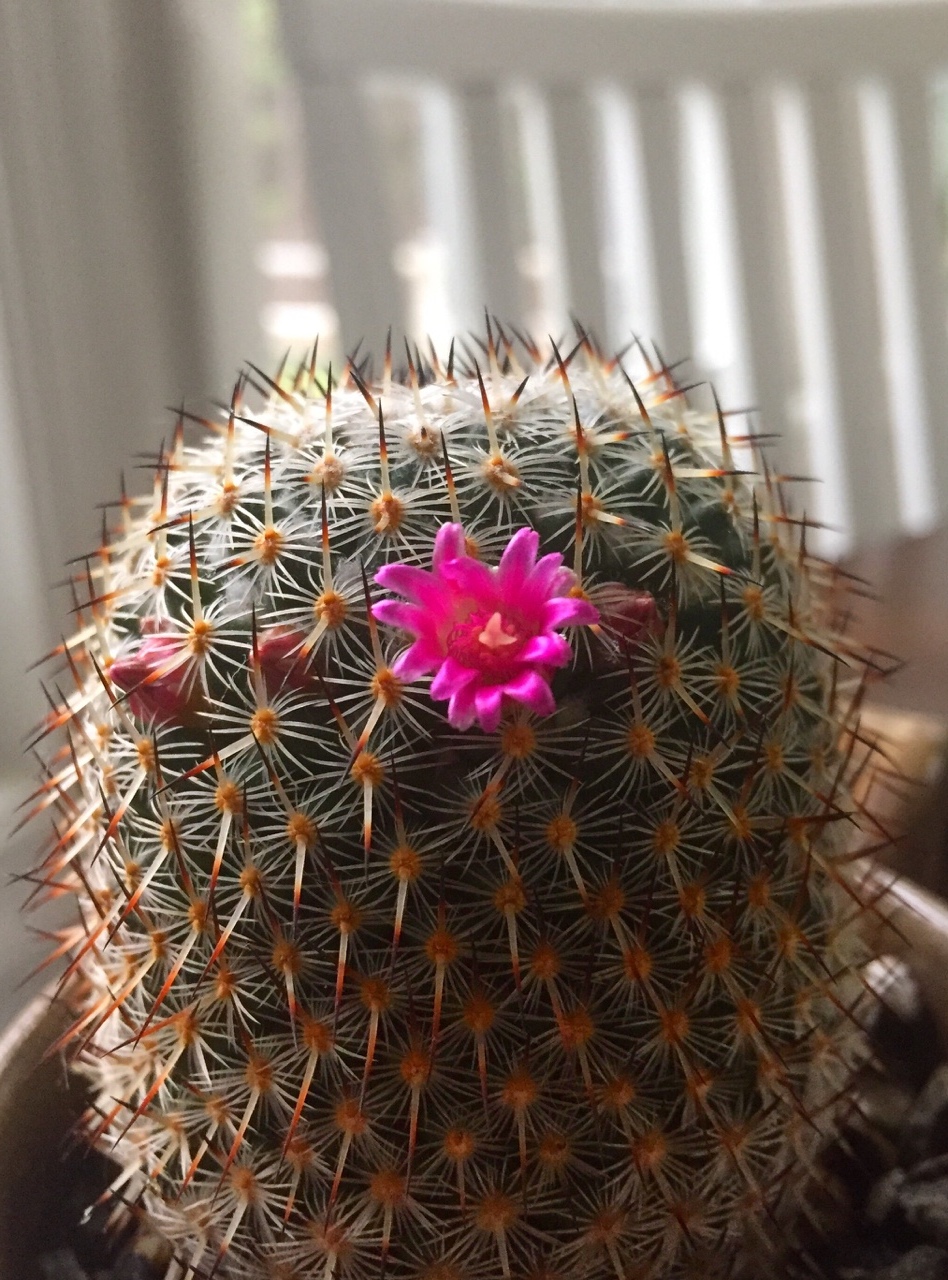
- Improperly created conditions for a dormant period or wintering
- The wrong pot
- Illiterate turning over a cactus pot relative to a light source
- Cactus age up to 5 years
- The plant lacks nutrients
How to make a cactus bloom?
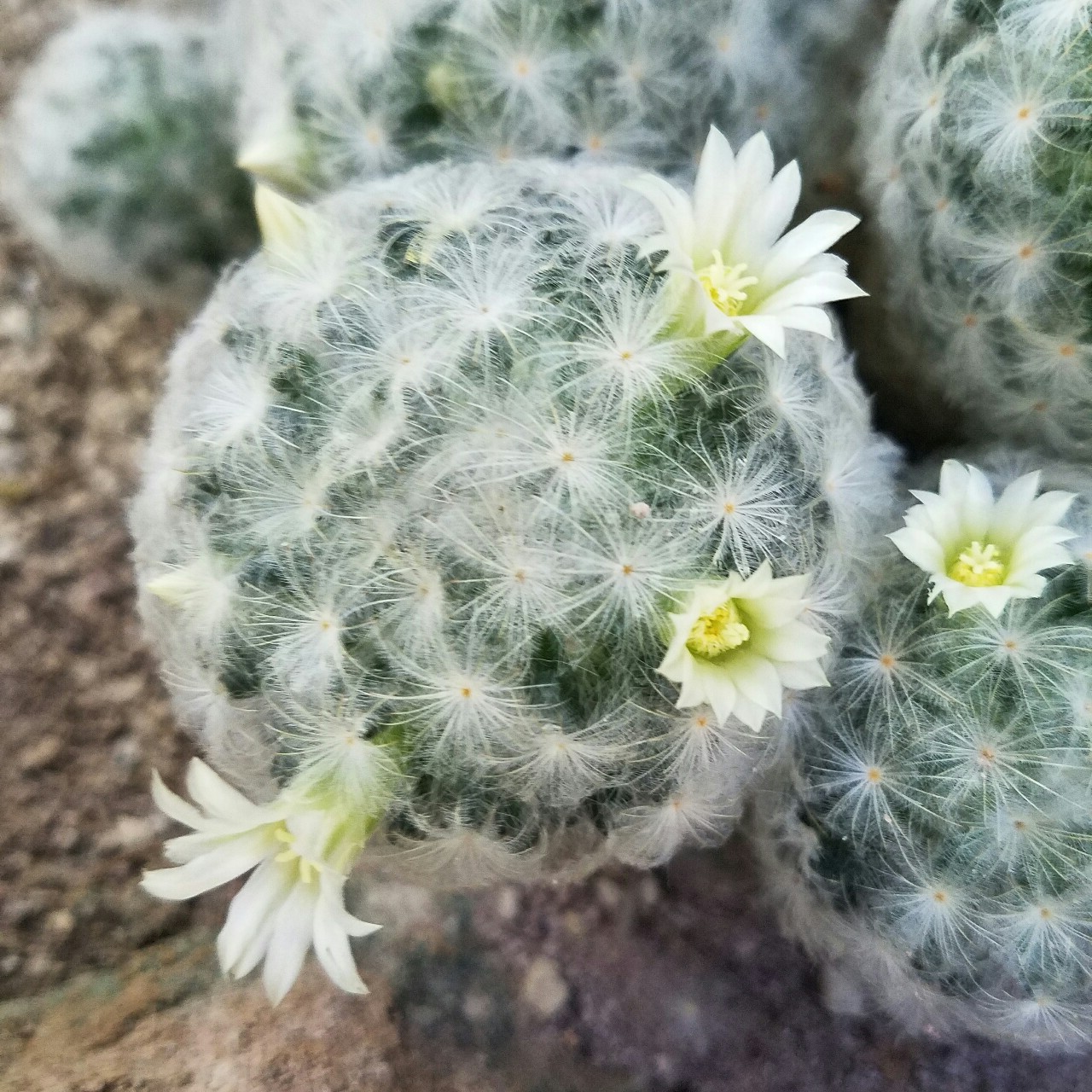
From the above reasons for the lack of flowering of a cactus, a number of actions can be deduced that will lead to the formation of buds and flowering.
Providing peace in winter
In order for the cactus to bloom, it needs to gain strength and take a break from the active growing season. Therefore, we need to ensure that the cactus stops growing and falls asleep for the winter.
In winter, cacti contain at +10, +12 degrees. The temperature should be constantly monitored. Additionally, cacti require a dry content. Watering is stopped for 1-2 months. If the plant looks too dry and shrinks before your eyes, you can water it once a month, but only with a very small amount of water.
In mid-February or early March, cacti begin to emerge from hibernation. To do this, gradually increase the air temperature and carefully spray the substrate with tepid water a couple of times a week. If cacti grow on a south window, with an increase in solar activity, make sure that the plant does not get burned.
We transplant a cactus
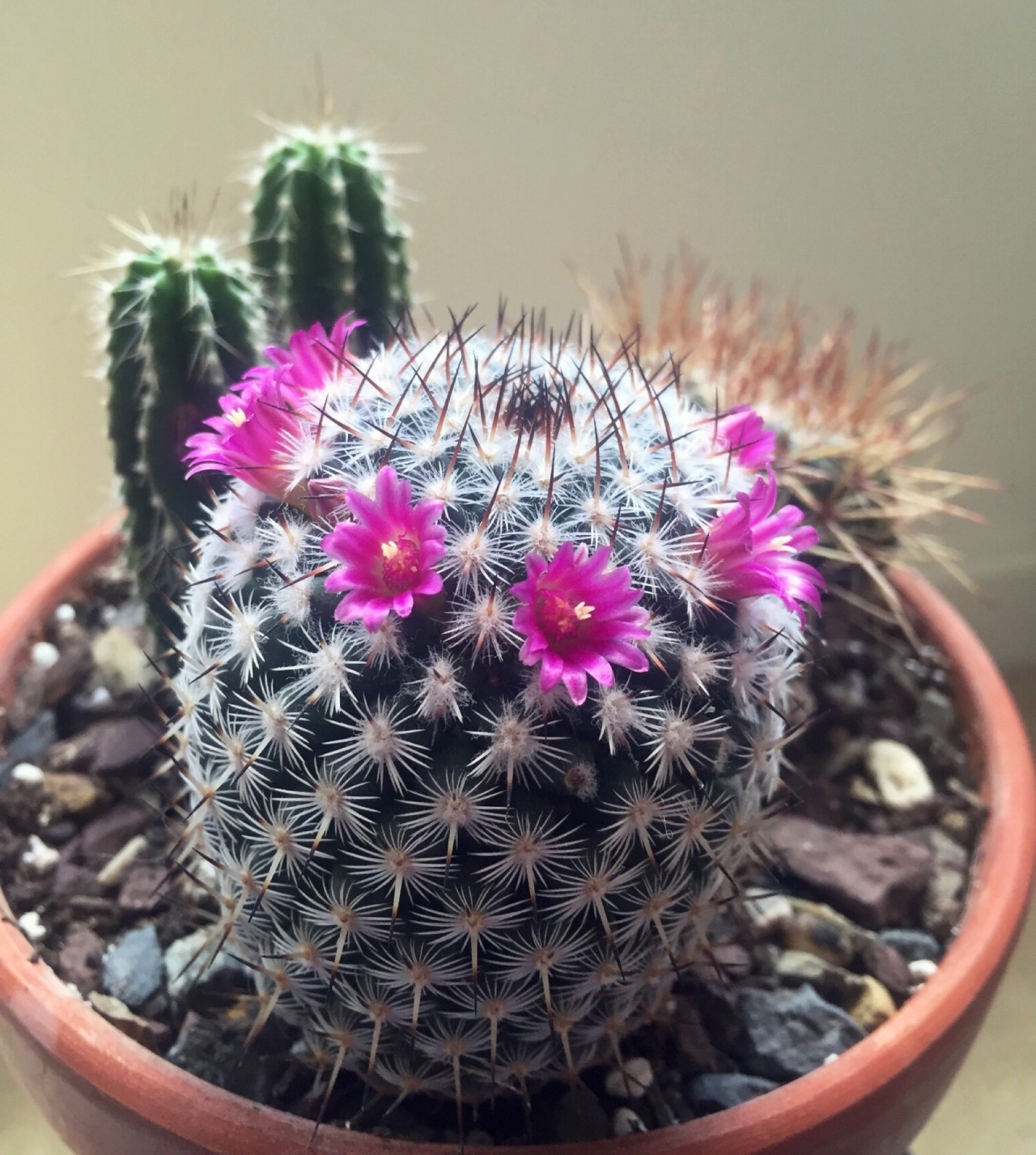
A cactus will only bloom if it is grown in the right pot. It should not be a deep pot, suitable in diameter to the cactus. Do not take pots that are too wide, as there will be no flowering in this case. On sale you can find beautiful pots designed specifically for cacti. A week before the planned transplant, watering and fertilizing should be stopped for a week.
When transplanting, it is important to use drainage and specialized soil for cacti. Do not disturb the root system of the plant and clean off the old substrate from it. It is enough to partially replace the old soil. After planting, the cactus is watered only after five days.
Choosing the right location
The cactus pot is best positioned in an east or west window in soft lighting conditions. On a south window, even desert cacti can get severe burns if not properly controlled. You should not constantly turn the cactus pot, especially if you notice the formation of a future flower bud.
We make top dressing
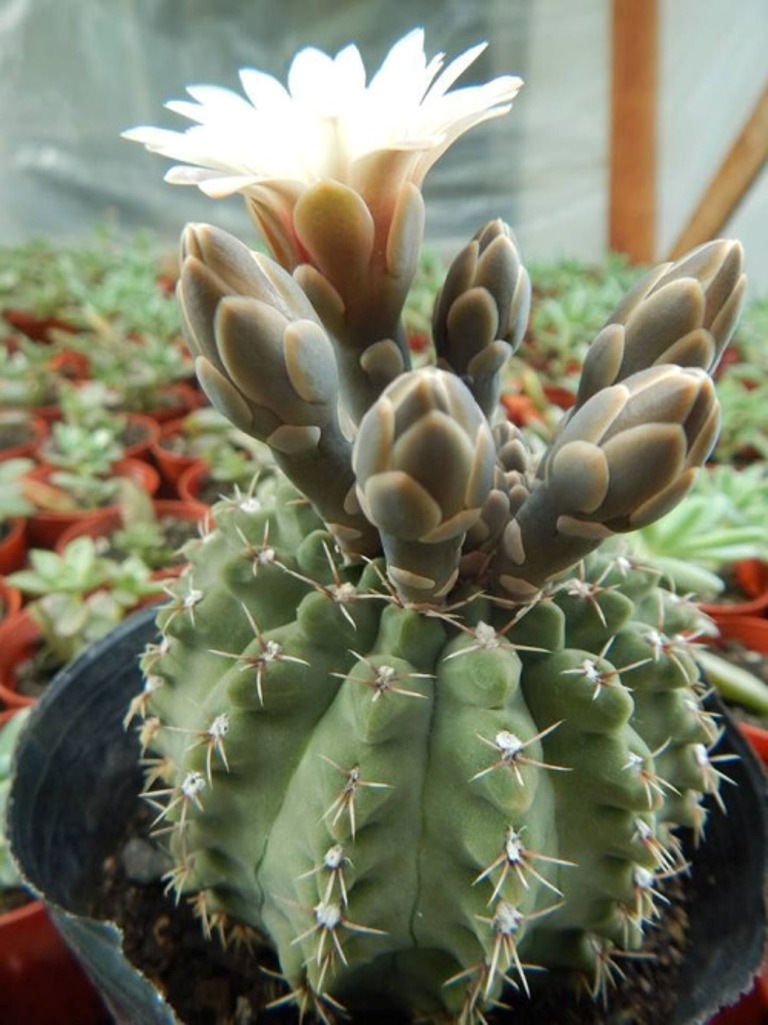
With the onset of active vegetation, the cactus requires regular application of mineral supplements. It is preferable to use ready-made fertilizers for cacti and succulents according to the manufacturer's scheme.
We water correctly
The cactus is watered about twice a week in summer as needed. And it occurs when the substrate is completely dry. It is very important to prevent stagnation of moisture in the pan and waterlogging of the soil.
If we pay due attention to the needs and health of our thorns, then very soon cacti in bloom will become the pride of the whole family.
They look very beautiful at any time of the year. Their satin-shiny stem is decorated with numerous, multi-colored spines and hairs, they look equally good both in summer and in winter.
But the one who has ever seen blooming cactus, - which happens quite rarely among lovers - will never forget the strange and peculiar beauty of its flowers.
It is clear that every florist wants to achieve flowering of his plants and all care, all year-round maintenance of the collection is planned in such a way as to create the most favorable conditions for this.
Conditions suitable for cacti to bud and bloom can be created in any collection.
Here are the main rules that will help achieve lush flowering of cacti:
First of all, cacti must be in the growth stage. It would seem that it is not worth talking about this, the very first and most important condition, but basically, a larger number of cacti in the collections of amateurs do not live, but survive, that is, they do not grow. One of the saddest and most common sights is the "on crutches" collection, in which each cactus is fenced in with an elaborate system of props and sticks. There is no future in such a collection - cacti that do not grow, lack living roots, gradually die; living and growing cacti do not need props, with the exception of forest species, whose shoots grow up to two meters in length, they should be tied up.
Cacti should not suffer from hunger or excess food. An exhausted cactus never blooms, just like a fattening one. The earth should be fresh and sufficiently nutritious, but not contain any organic fertilizers. It is very harmful to water the cactus with organic fertilizers, the buds have already been laid. Even in such an unpretentious species as minuscule rebutia, soon after watering with a solution of mullein, pink buds begin to turn green and turn into “kids” right in front of an upset owner.
Cacti should receive enough sunlight. If they don't get it for at least 3 hours a day, at least, they don't have to wait for flowering. Many believe that only with a south window can flowering be achieved. In fact, cacti also bloom on other windows, but flowering comes a little later than on the south.
Cacti need to get plenty of fresh air. Often amateurs underestimate the importance of being outdoors around the clock, protected only from rain, wind and gunpowder. It is especially useful to have cacti camped outdoors in late summer and autumn because it hardens them and prepares them for the winter. The clean, cool air of autumn nights promotes the maturation of new growth, on which buds are laid, as well as the compaction of the stem and the skin covering it. Cactus after such hardening is much less likely to be affected by diseases and pests.
The sun should illuminate the cactus from one side only. This rule is in most cases violated by amateurs, worried about maintaining the correct shape of the stem. They try to make the top of the cactus have a slope, for this they often turn the pot, changing its orientation relative to the sun. In this case, the stem grows evenly, but it will not bloom, moreover, it is enough to return, having already collected buds, the cactus with the other side to the sun, or move it to another room, and the buds will fall off or dry out. You can correct a distorted stem by turning the pot after flowering has ended. For this, usually 1 - 1.5 months of illumination on one side is enough. Some species do not tolerate any rearrangement of the pot at all during the budding period. Zygocactus, for example, sheds buds if you rearrange the pot without even turning it in the other direction.
Wintering cacti
should be dry and cool. (Cacti from the tropical forests of Brazil are an exception to this rule, they winter at high humidity and temperatures of plus 15 - 20 ° C). For the ripening of summer growth and for laying buds, cacti need an annual rest, i.e. cessation of growth during the dark winter months. If growth is not stopped for the winter, the plant will be depleted, give an ugly growth and not bloom the next summer.
You can stop growth without harming the plant by gradually reducing watering from autumn, bringing it to a minimum in winter. At the same time, a decrease in temperature is necessary to slow down the processes of respiration and evaporation of water by plants. + 10-15°C can be considered the best temperature for keeping most types of cacti in winter, but alpine species bloom only when wintering is cold + 5-8°C.
Transplantation of early-flowering species should be postponed until the end of flowering. No matter how correctly and carefully it is done, spring growth is always slightly disturbed and delayed due to the inevitable damage to the roots, and also because of the need for a “dry rest” of a freshly transplanted plant. If the transplanted cactus began to pick up buds, then the latter will dry out and fall off. Therefore, transplantation should not be carried out before flowering.
In the same way, it is not recommended to cut the “babies”, or cut the cuttings from a cactus ready for flowering, as this can disrupt the metabolic process that takes place in the plant, and bud growth will stop.
It is very pleasant when cacti bloom, but this is difficult to achieve. You need attention, work, observation and patience, most of all patience. It should not be forgotten that even the most proper care will not give instant results - you need to love your plants, watch them, study their behavior - and they will bloom.
If you like our site tell your friends about us!
Add site to bookmarks
What types of cacti bloom indoors?
- Wilcoxia and Rebuxia
- Mamillaria and Frailea cactus
- Echinopsis and Opuntia
Many lovers of indoor floriculture are interested in which cacti bloom. These amazing plants often amaze with their singularity and beauty. It is especially surprising when the cactus begins to bloom. As a rule, this does not happen so often, but it does occur even in normal room conditions.
Cacti bloom quite rarely, but with proper care they can please flower growers with their beauty.
Experts divide all flowering cacti into 2 varieties: forest and desert. Forest species in the wild grow on trees and tall plants. Growing them at home is quite difficult, even almost impossible. But desert cacti are successfully grown indoors. However, there are many species that are distinguished by their beautiful colors.
Wilcoxia and Rebuxia
Very often in a flower shop or nursery you can find a plant like Wilcoxia. This type of cactus looks like thin elongated green sticks, which are covered with small needles. Growing, these sticks become taller, begin to intertwine with each other, forming bizarre shapes.
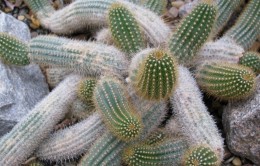
Wilcoxia cactus, under the right conditions, can bloom annually.
With proper care, such a cactus will bloom every spring. At the same time, the outwardly unremarkable cactus of this variety is distinguished by small, but very beautiful pink flowers, which have many pointed petals. For annual flowering, keep the cactus in a tight pot on a well-lit windowsill in a room that is frequently ventilated.
A fairly common species in indoor floriculture is Rebuxia. This cactus has a spherical shape, numerous very thin white spines. Rebuxia blooms every spring in March or April. In this case, the flowers are usually very large, the size can be even larger than the plant itself. Depending on the variety, Rebuxia can bloom in red, pink and even purple.
But in order for this type of cactus to please with its flowers every year, you need to water it as often as possible so that the earth in the pot always remains moist. At the same time, before spring, you need to stress him: take him out at the end of winter to a cold room. In early March, place again on a warm, well-lit window.
Back to index
Mamillaria and Frailea cactus
Mamillaria is considered one of the most unpretentious flowering cacti. This variety has been bred for a very long time. At the same time, the cactus is not particularly demanding on the conditions of detention. It is enough to water the plant in a timely manner (but only so that the soil does not turn sour), protect it from constant direct sunlight.
The cactus itself consists of a large number of small balls, which are dotted with light yellow or almost white needles. Such a flower constantly releases children, due to which it constantly increases in size. Between the needles you can see a thin soft cobweb. Mamillaria usually blooms in a bright crimson color. At the same time, this species produces very small buds at the top, which subsequently very much resembles a bright raspberry wreath.
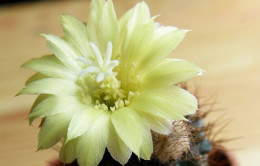
Frailea cactus is valued for its large yellow flowers.
For frequent flowering, such a plant requires almost nothing. It can produce buds even at a relatively young age, for which many collectors like it. You should only try not to touch the pot during the beginning of flowering, not to rearrange it from place to place so that the cactus does not drop buds.
Another flowering variety is the Frailei cactus. The plant looks unremarkable. The cactus is distinguished by a small stem of a cylindrical or almost spherical shape. It is dotted with long yellow spines, the ends of which are slightly twisted.
In order for such a plant to bloom, it should be provided with good watering and lighting in the summer, but at the same time, relative cold and minimal watering in the cold season. In winter, it is best to transfer this cactus variety to a room where the ambient temperature should be at the level of 10-11 ° C.
This plant blooms very large beautiful flowers yellow, for which it is highly valued. In this case, it most often happens that these flowers are 1.5-2 times larger than the plant itself. In most cases, one cactus releases one flower, but sometimes it can release 2 or 3 buds.
Cacti, as houseplants, began to spread in connection with the advent of home computers. Since many believe that these plants are able to reduce radiation levels. Cacti in general are unpretentious succulents, but even such, accustomed to weather surprises and drought, can get sick and die if the rules for their maintenance are violated. This plant is unusual, so caring for it should be different from caring for other plants in the flower garden.
natural habitats
The homeland of the cactus is America. But they also grow in sultry parts of Africa, Asia, and can even be seen in Europe. In nature, they are huge. They prefer to settle in arid regions of the globe and feel good in Argentina, Chile, and Mexico. The plant has many species, some of which grow in tropical forests. They can also be seen on the shores of the Mediterranean and Black Seas.
natural conditions in which cacti feel good:
- Low humidity. Most species prefer regions with low humidity. However, some prefer a high level of moisture, so they live only in tropical forests.
- Temperature changes. We are accustomed to feel the temperature changes that occur in deserts. There, the difference between day and night temperatures is up to 50 degrees.
- Loose substrate. Usually cacti grow in mineral soils, for example, gravel or sand are suitable, the main thing is that the composition is loose. However, some species prefer the oily ground of the rainforest.
These plants have a fleshy stem and thick skin. This feature was formed in the process of evolution, it allows the plant to adapt to the lack of water.
To prevent moisture loss in cacti There are defense mechanisms
- Instead of leaves, thorns.
- Hairs on the epidermis.
- Wax coating.
- Stem consisting of ribs.
- Deep root system.
cactus care
It is not difficult to care for cacti, but you still need to know some important points:

For the cactus to bloom
Some cacti bloom at a young age. But there are some, for example, prickly pear or cereus, which are quite difficult to bloom. In order for cacti to show their decorative flowers, they need to create conditions that resemble natural ones. How to make a cactus bloom at home?
As a rule, in a room, a cactus begins to bloom when it reaches three or four years. From this age, every year in the spring they will delight you with their beautiful flowers. You can find out which cacti bloom at different times during the year and build a collection. Then there will be no break in the flowering of cacti.
The secret of cactus flowering lies in the fact that most plant species can only bloom on new growth. In order for it to appear, it is necessary to provide high-quality care throughout the summer, and in winter to arrange relative rest for the plant. It should also be noted that the laying of flowers occurs in a slightly cramped pot.
Types of cacti and their names
Below are the types of cacti that grown at home, names are given and brief characteristics varieties.
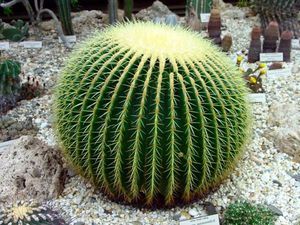
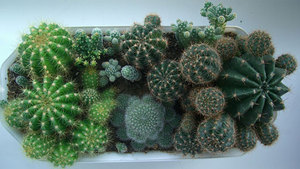 Cacti have long lived with us in apartments, but they are rarely used as an important element of decor. However, some lovers of these plants still consider them in this role. Decorators should protect yourself from thorns that pose a threat to humans. Wear thick gloves when interacting with these desert dwellers.
Cacti have long lived with us in apartments, but they are rarely used as an important element of decor. However, some lovers of these plants still consider them in this role. Decorators should protect yourself from thorns that pose a threat to humans. Wear thick gloves when interacting with these desert dwellers.